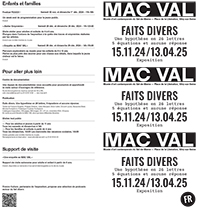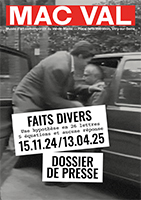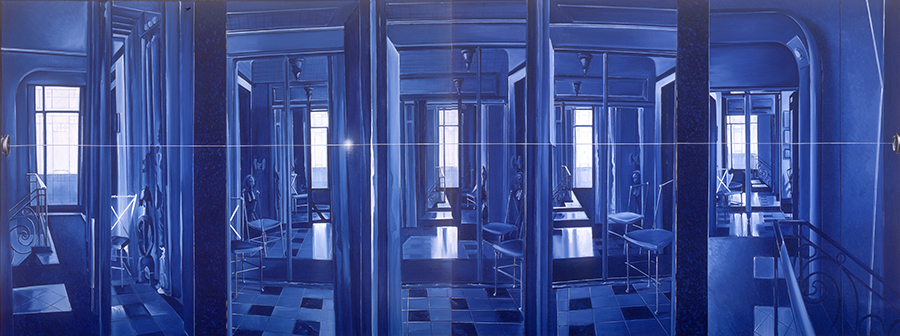Under the curatorship of director Nicolas Surlapierre and Vincent Lavoie, an art historian and professor at the Université du Québec in Montréal, the Musée d’Art Contemporain du Val-de-Marne has undertaken a major investigation into the subject of the fait-divers, resulting, this autumn, in a major exhibition bringing together no fewer than 80 artists from a wide range of backgrounds and formal practices. “Faits divers” has been awarded the “national interest” label, not only for the originality of its content, but also for the museum’s strong commitment to reaching out to all kinds of audiences, from experienced viewers to newcomers. Visitors will be able to decipher the workings of the genre through an innovative scenography that provides interpretative keys to the many artistic proposals that explore the fait-divers. And as is suggested by the exhibition’s subtitle, “A hypothesis in 26 letters, 5 equations and no answers,” here each visitor can give free rein to their imagination and personal judgement.
This group show marks the 20th twentieth anniversary of the founding of MAC VAL, an event that will be celebrated throughout 2025. The inspiration for the theme came from Roland Barthes’ essay “Structure of the Fait-Divers” (1964). Described by the semiologist as the “unorganised discard of news,” the fait-divers helps us to name and identify the aberrant causalities and coincidental relationships that disrupt everyday life. This exhibition offers a broad and comprehensive overview, allowing for comparison, and plays on the principles of enigma and trickery. The fait-divers is the revelation of the unfathomable mystery of banality. It is the grain of sand that causes dull routine to seize up, brutal anomie, the explosion of violence beneath still waters, the cruelty of good honest folk. It is also the revenge of the obscure, of the nobodies.


Text by the curators of the exhibition
Nicolas Surlapierre and Vincent Lavoie
Director Nicolas Surlapierre chose to share curating responsibilities with art historian Vincent Lavoie, a professor at the Université du Québec in Montréal. The catalogue published on this occasion features contributions by leading specialists in the field.
Despite real interest in the subject, no exhibition in France has really been devoted to an artistic analysis of the fait-divers. The exhibition “Faits divers” held at the Musée des Arts et Traditions Populaires in 1982 looked at the subject through the prism of the press and ethnographic objects related to faits-divers. Similarly, the recent exhibition at the Musée de l’Image in Épinal showed how prints and press illustrations took up faits-divers, and were for many years the chief means of disseminating them. In the field of art, two exhibitions have shed light on the question. Régis Michel’s La peinture comme crime at the Musée du Louvre in 2001, and Jean Clair’s Crime et châtiment at the Musée d’Orsay in 2010, presented works of art (including 20th century art), but their purview was limited to crime. The exhibition at MAC VAL, on the other hand, will offer a broader, more comprehensive panorama, with a comparative slant, and will play on the principles of enigma and trickery. After all, faits-divers are as much about stories as they are about worlds and imaginaries.
Without a doubt, Roland Barthes’ “Structure of the Fait-Divers” 1964) was the inspiration for this exhibition.
Described by the semiologist as the “unorganised discard of news,” the fait-divers helps us to name and identify the aberrant causalities and coincidental relationships that disrupt everyday life. If, as Pierre Bourdieu famously put it, the fait-divers is a diversion, it is also one of the major manifestations of the society of entertainment. But while they may tell us nothing about reality, faits-divers do suggest its complexity and depth. The fait-divers is the revelation of the unfathomable mystery of banality. It is the grain of sand that causes dull routine to seize up, brutal anomie, the explosion of violence beneath still waters, the cruelty of good honest folk. It is also the revenge of the obscure, of the nobodies.
The fait-divers marks a break in the process of civilisation. It is aimed at a literate public, it requires a topical medium, in particular the press and media, and it is now updated on the new communication media, which themselves contribute to the plasticity of its structure and form. It holds a real fascination for artists, who have come up with all kinds of formal outlets and typologies. It can be cruel, funny, comical, ironic and cynical all at the same time. None of the major art movements of the 20th and 21st centuries have escaped the influence and shadow cast by the news item. The exhibition will showcase a wide range of artists working with diverse media and approaches. There will be no fewer than 80 of them, and over a hundred works will be on display.
Beyond the illustrative nature of the alphabetical guide, the fait-divers is also an excellent vehicle for questioning certain protocols and modus operandi in contemporary art. The “fictionalisation” of the so-called minor event, the resonance of the indexical model, the artistic transposition of investigative protocols: reconstitution, inventory and collection, the play of differing temporalities in representations of events, the ethics of testimony and evidentiary discourse, sensationalism and regimes of affect, and finally the effects of authenticity and clashes of opinion will all be evoked in each of the five equations that structure the exhibition.
Because the faits-divers is often linked to the world of investigation, to a certain form of enigma and to the desire of artists to elucidate the mysterious side of these events, the exhibition is built around the poetry of equations with several unknowns, which are conceived as a cross between parameters and a register of “indexicality.” Each of the equations will be introduced by “exhibits” of the kind presented in court, underpinning the legitimate metaphor of investigation and hinting at the miscarriage of justice or human error at the root of many faits-divers. The present exhibition is as much a universe of forms as it is a vast lexical field. The thematic guide, which refers to Didier Decoin’s Dictionnaire amoureux du faits divers (Éditions Plon, 2022), aims to show the diversity of artists and forms that have taken a close interest in these singular events, with their indefinable and indecisive intimations. It will also highlight the impact of the visual culture of the faits-divers on contemporary art. In 26 letters and 5 equations, the exhibition will present a hypothesis of what a fait-divers is, but will be careful not to impose an answer. It will leave everyone free to make up their own minds, to have their own doubts, or simply to let themselves be carried away by the delights of fabrication and speculation.
A powerful catalyst for emotions (compassion, pleasure, curiosity, identification), the fait-divers has a fantasy value that plays a part in dramaturgy and contemporary art. The number and variety of these artistic practices encourages us to analyse the status of this subject in contemporary art. This exhibition examines the ways in which this protean category of narrative is transposed into contemporary art. The aim is not so much to examine the place occupied by faits-divers and events of a criminal nature in the history of art as to analyse their various occurrences in artistic creation from the 1960s to the present day. More fundamentally, the exhibition seeks to examine the links between contemporary art and the imaginary world of the news, which artists not only illustrate or document in their own way, but also reinvent.
In the mathematical sciences they are variables and correspond quite neatly with the world of enigmas to be solved. They sum up artists’ desire to elucidate the enigmas that are sometimes or often subjacent to a fait-divers and transform the museum’s temporary exhibition rooms into a vast board game, in reference to the famous game. Each equation brings together 5 or 6 letters from the alphabet. They break with alphabetical order, so that visitors can grasp the lexical field of “diversified facts,” the main themes, the diversity of responses proposed by the artists and the issues of reception. The equations describe broad categories or archetypes: “In the name of the law” (equation with one unknown), “Disaster scenario” (equation with two unknowns),”Doing violence” (equation with three unknowns), “Open your eyes” (equation with four unknowns), “The shadow of a doubt” (equation with five unknowns).
French site
C’est très certainement la lecture du texte de Roland Barthes Structure du fait divers (1964) qui est à l’origine de cette exposition. « Frère bâtard de l’information », selon le sémiologue, le fait divers nous aide à nommer et à identifier les causalités aberrantes et les relations de coïncidences qui viennent bouleverser le quotidien.

